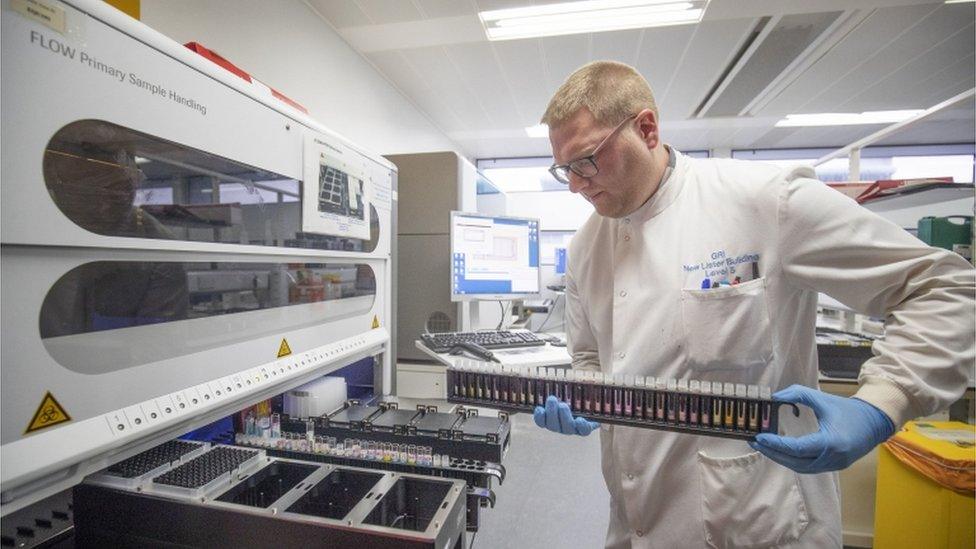How are the Covid levels decided?
- Published

The Scottish government has set out the "indicators", external it will use when deciding which of the five levels of Covid restrictions each local authority area will be allocated.
The indicators look at levels of infection and transmission as well as hospital capacity.
Number of cases
The first indicator is the number of cases per 100,000 people, including for particular age groups. This uses the latest actual data and a two week forecast.
Orkney currently has no cases and the rate is low on Shetland and the Western Isles. Moray has a rate of just 15 per 100,000.
At the other end of the scale South Lanarkshire has a rate of 355, well above the threshold for level four. North Lanarkshire would also fall into level four.
Positivity rates
This looks at the seven-day average of the number of positive tests in relation to all tests carried out over the past week.
Glasgow City, East Dunbartonshire, North Lanarkshire, South Lanarkshire and West Lothian are all above the 10% threshold for level four.
The World Health Organisation set 5% as a level to cause concern.
Hospital capacity
Nationally, there are an estimated 2,000 hospital beds available.
The share in the Lanarkshire health board area is 242. The current six-week forecast is that NHS Lanarkshire could need 705 beds for Covid patients.
In contrast, NHS Highland has 118 beds but will only need 26 on current projections.
The ICU capacity in Lanarkshire is 15 but that can be doubled to 30. The forecast demand in five weeks' time is 76.
Glasgow, which also has high transmission, can double ICU capacity to 76 and the forecast demand in five week is 77.
Fife, in contrast, can double capacity to 20 but is forecast to need eight.
What are the thresholds for each indicator?
Using the indicators it is possible to set thresholds to act as a "signalling mechanism". Once the indicator reaches these thresholds it will indicate consideration of whether a change in level is required.
The indicator paper said there were various ways of combining the criteria and freedom to take in other information must be allowed,.
The ranges remain a "work in progress" and are likely to be adjusted.
A local authority area is considered for level 4 when it "broadly" meets one of the following conditions:
more than 300 cases per 100,000 people
more than 10% positive tests - twice the rate for national concern given by WHO
very high probability of 500 cases per 100,000 forecast in two weeks' time
the projection of hospital bed use in the health board in three weeks' time is greater than the health board's share of 2,000 beds nationally
the projection of ICU bed use in the health board in two weeks' time is greater than twice its normal capacity
An area is considered for level 3 when it does not meet level 4 and it broadly meets one of the following conditions:
between 150 and 300 cases per 100,000 people
between 5% and 10% positive tests
very high probability of 300 cases per 100,000 in two weeks' time
the projection of hospital bed use in the health board in four weeks' time is greater than the health board's share of 2,000 beds nationally
the projection of ICU bed use in the health board in three weeks' time is greater than twice its normal capacity
An area is considered for level 2 when it does not meet level 3 and it broadly meets one of the following conditions:
between 75 and 150 cases per 100,000 people
between 3% and 5% positive tests
Very high probability of 100 cases per 100,000 in two weeks' time
the projection of hospital bed use in the health board in five weeks' time is greater than the health board's share of 2,000 beds nationally
the projection of ICU bed use in the health board in four weeks' time is greater than twice its normal capacity
An area is considered for level 1 when it does not meet level 2 and it broadly meets one of the following conditions:
between 20 and 75 cases per 100,000 people
between 1.5% and 3% positive tests
Very high probability of 50 cases per 100,000 in two weeks 'time
the projection of hospital bed use in the health board in six weeks' time is greater than the health board's share of 2,000 beds nationally
the projection of ICU bed use in the health board in five weeks' time is greater than twice its normal capacity